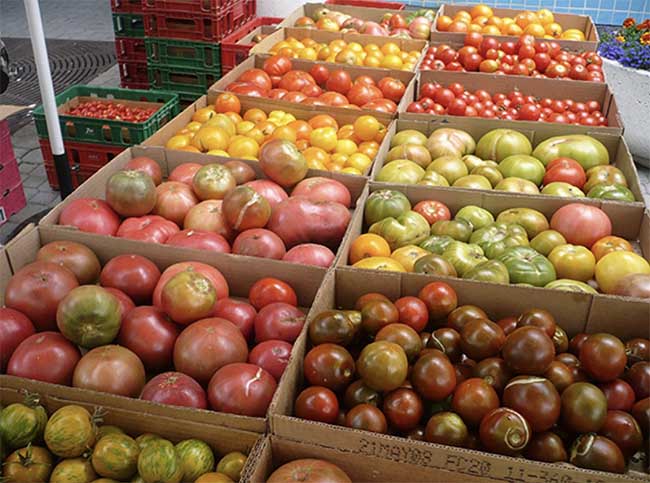Growing tomatoes is one of the best gardening experiences out there. If done in the right way, tomato growing can be quite profitable. Growing tons of tomatoes is quite exciting. But there are problems when growing tomatoes and you need to get it right.
The experience can be worse when diseases kick in, the weather gets worse or harvests are not bountiful. But overall, the experience is a great one. Tomatoes are a top crop for every gardener.
But ever wondered how farmers grow tons of tomatoes successfully? Join me as I share experiences from farmers on growing tons of tomatoes.
Choosing a tomato variety
You first need to choose a tomato variety. Farmers know varieties that grow faster and have big demands at the farmers’ market.
There are two common tomato varieties to grow, determinate and indeterminate. Determinate tomatoes are bush varieties that grow 2-3 feet tall. They are ideal when you want numerous ripe tomatoes at once.
Determinate tomatoes produce fewer leaves and produce tomatoes for a shorter period. They are perfect for growing in tomato grow bags, containers, and gardens with small spaces. Determinate tomatoes are ideal for making paste. They are also ideal for canning since they produce at the same time.
We also have indeterminate which experience more leaf growth. They are also called vining tomatoes and produce late-season up to early frost production. Most indeterminate tomatoes are cherry tomatoes and beefsteak tomatoes.
Perfect period to plant
Next, you need to pick the right time to plant. Tomatoes are long-season plants that will take 60-100 days. They love heat and most won’t tolerate frost. This means choosing a suitable period to plant so that you can harvest before frost. If the weather is too hot or cold for growing tomatoes outdoors, you can consider growing them indoors with the help of grow lights specifically designed for tomatoes.
Seedlings should be planted six weeks before the first spring-frost date. Tomatoes have a long-growing season. Timing should be done to ensure you plant your seedlings by the time the weather gets warm.
Apart from growing seeds, you can choose your seedlings from a nursery.
Soil Requirements – Fertilizing
Next, you need to understand the soil requirements for tomatoes. First is the fertilizer needed, Stephanie – master gardener and regular contributor to Backyard Gardeners Network said that tomatoes use different fertilizers for different growing stages. So start with a soil test to determine what fertilizer to add.
In the 2 to 3 months of growing, farmers can apply fertilizer 10 times. Before planting, farmers need to add well-rotted manure to the rows. Before planting, they also need pre-planting fertilizer. This is fertilizer rich in nitrogen.
As the tomatoes grow, farmers need to apply fertigation. This is the most common tomato fertilizer. It is a water-soluble fertilizer that is applied to the drip-irrigation system. The application provides tomato plants with gradual nutrients giving them time to grow.
After every three days, fertilizer with Calcium is added until you see the third inflorescence set. Afterwards, farmers can change the Nitrogen-Phosphorus-Potassium ratio to 1-1-2. The ratio is again changed to 1-1-3 when fruits are mature.
Higher potassium is needed towards maturity as tomatoes need it to produce bigger and well-shaped fruits.
Most successful tomato farmers recommended creating a fertilization calendar. While every field is different and has different needs, you should know the tomato fertilizer needs.
During the growing season, tomatoes grown outdoors require up to 700mm of water. It’s crucial to water plants during the flowering season, when the fruits are setting and during the fruit filling period
Watering should be done early in the morning and late in the evening. However, when watering, make sure you avoid water touching the foliage. Excess moisture on the foliage can lead to disease outbreaks.
Pruning, Staking and Pinching
As the tomatoes grow, you need to prune and pinch the suckers. This is a great way to allow sunlight to access all parts of the plant and air to circulate properly.
Additionally, you need to tie the stems to stakes. You also need to trim lower leaves from as low as 12 inches.
Harvesting and storage
Most tomatoes are ready for harvesting from 7-10 weeks after transplanting them. If the tomatoes are intended for canning, they are harvested mechanically at once. This usually happens in late summer when they are fully ripe.
But tomatoes for local selling at a farmers market can be harvested by hand. Harvesting can be done in two stages towards the ripening season. Harvesting can be done 2-3 times a week.
Overall, you need to harvest tomatoes when they are red and firm. Most can have some yellow on the stem.
What happens when temperatures drop and the tomatoes are not fully ripe?
Pull the entire tomato plant from the soil. Then remove all foliage and dirt leaving the tomato fruits attached. Hang the plant upside in a garage for a few days for the tomatoes to ripen.
Mature pale and green tomatoes can also be stored in boxes to ripen. You need to maintain cool temperatures. Never put the tomatoes on direct sun to ripe.
